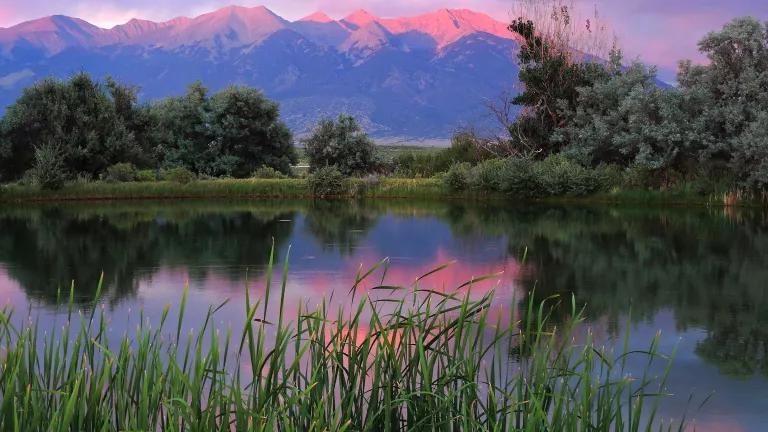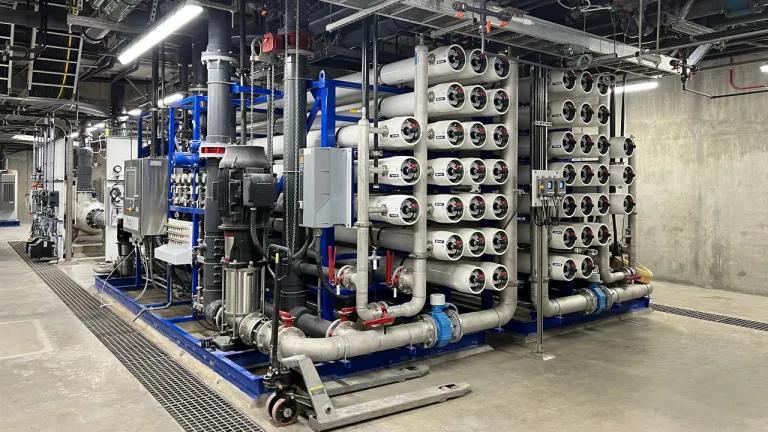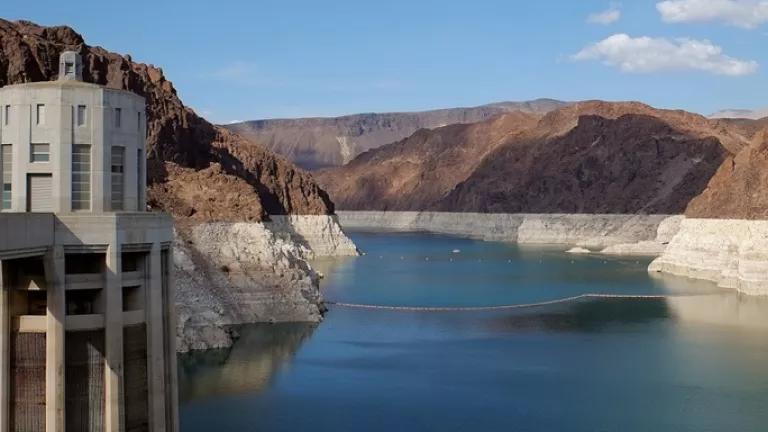Texas Shows Us Our Water Future with Climate Change: It Ain’t Pretty
Texas was just a glimpse of what’s to come. With increasing wildfires, drought, flooding, and sea-level rise, we must make sure our water systems can continue to operate during such events.
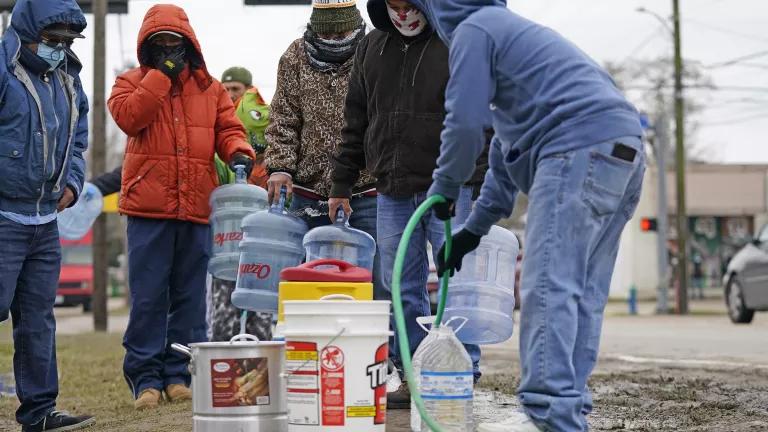
Houston residents fill up coolers and jugs with water from a park spigot as others wait in line.
AP Photo/David J. Phillip
Earlier this week, 1 in 22 Americans didn’t have water or was on a boil water alert. Nearly 15 million people in Texas alone were without safe drinking water in the wake of the massive storm, cold snap, and power outages. Many more in Oklahoma, Louisiana, and other hard-hit Southern states also lost water or were on “voluntary” or mandatory boil water alerts. Wastewater treatment plants lost power and spewed more than a million gallons of raw sewage into frigid waters, threatening downstream users. The misery of being unable to flush your toilet, shower, or safely drink water in your own home was often compounded by the chattering teeth and sleeplessness from unbearably cold bedrooms. Low-income families and people of color were disproportionately harmed by breaking pipes and power failures, just as they are disproportionately at risk from contaminated water supplies.
Unfortunately, this overwhelming storm and cold snap are only a glimpse of the coming impacts of climate change on our water supplies. Soon to return are the wildfires that destroy homes, choke communities with thick smoke, and melt or destroy plastic and other pipes and other water infrastructure, causing serious tap water contamination and loss of water pressure. These fire-related drinking water disasters have been recorded during several recent years in California and elsewhere.
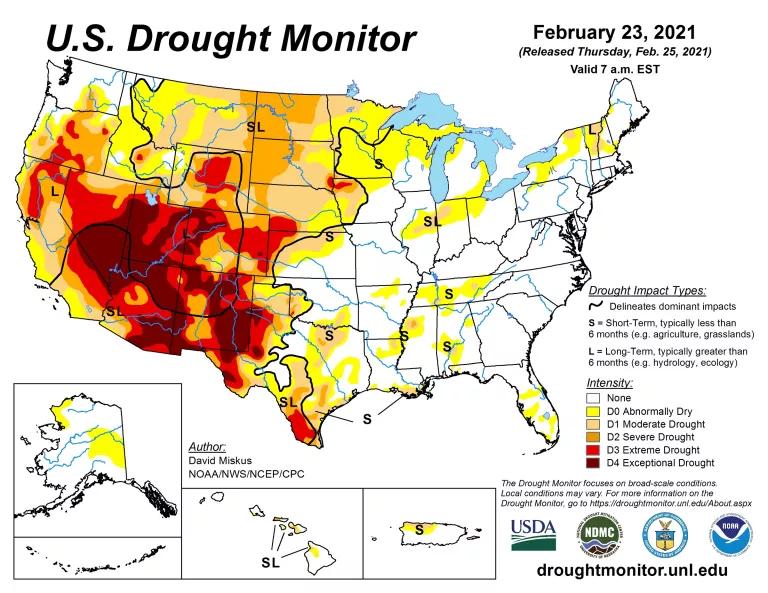
And then there’s drought. Reduced snow melt from upstream mountains means lower flow into downstream water sources. And drought conditions (see map) can parch entire regions, causing severe water shortages.
And there’s more. Also triggered by climate change flooding and sea level rise increasingly threaten drinking water and sewage treatment plants that are often in flood plains or coastal areas. With increasingly violent storms and hurricanes, these plants and our water infrastructure are vulnerable to repeated catastrophic flooding that can overwhelm and effectively end water treatment. Severe flooding has also caused spills or release of toxic materials or raw sewage into waterways that can end up in our tap water.
I hate to say it, but this is not a prediction of what the future looks like: This is now. And we must act.
Here’s what’s needed. First, we must make prevention of further climate change a top priority. But that will not be enough. We also need to adapt to what the future already has in store. We are already seeing major problems and growing impacts from climate change—and we have only experienced about 1 degree Celsius of warming to date. These problems will get worse, even if we achieve our most optimistic emissions reduction goals and limit warming to between 1.5 degrees Celsius and 2 degrees Celsius. We must prepare our water infrastructure for the inevitable results of climate change already in the works—and for the possibility that we may not limit warming to 2 degrees Celsius.
When communities are siting and designing new water infrastructure, it must be done with consideration of what the future could look like, not just today’s operating conditions. But that is all too rarely done. By and large, we build these systems based on past history, not the future climate these facilities will operate in.
That’s slowly starting to change. President Biden recently reinstated a federal flood protection standard, which will require federally funded infrastructure to factor in an additional margin of safety for flooding and consider future sea level rise. NRDC has also petitioned the Federal Emergency Management Agency to establish higher flood protection standards for critical infrastructure, like water and wastewater facilities, among other things.
For existing water and wastewater systems, we need to think of ways to make sure they can continue to operate during extreme weather events, like floods, droughts, and power outages.
Where possible, utilities should flood-proof key structures and equipment, or plan now to move to higher ground. To maintain essential service during power outages, water and wastewater plants should secure a portion of their power from green on-site sources that are independent of the grid and ensure backup power sources. They can also bury pipes deeper and insulate infrastructure against freezing and heat, install additional water storage so intakes can be shut off in the event of a spill or contamination, and store more water at higher elevations so they can use gravity if there’s a power outage. Wastewater utilities should also implement resilient or green infrastructure to help absorb excess rainfall from increasingly severe storms. We also need to protect wetlands that help to trap floodwaters and get rid of the Trump administration’s Dirty Water Rule that weakens protections of surface waters.
Utilities need to modernize water treatment that cannot remove modern contaminants and upgrade decrepit water distribution lines that are susceptible to decay, breakage, and freezing. Federal and state funding support will be critical to achieving that, along with standardized annual reporting of leakage to document progress. And states need to adopt and practice executing emergency plans to provide safe drinking water when a community loses it—something the law has required since 1974 but that has largely been ignored. An important part of the solution is to make sure that the people who are most affected by decisions regarding water systems have meaningful control of them, and that the operators of these systems are accountable to those who they are supposed to be serving.
Upgrading and rebuilding our water and sewage treatment plants to address today’s threats and be ready for climate change won’t be cheap but here’s the kicker: if we wait any longer, we’ll pay billions of dollars more.
To help fix the systems we count on when we use tap water and flush our toilets will require a federal investment of at least $20 billion dollars a year for drinking water and clean water infrastructure. State and local governments and utilities must also step up with significantly more investment. We urge the Biden administration to work with Congress in the federal reconciliation legislation and/or infrastructure legislation this year to make these crucial investments. We must recognize the stark reality: Our water supplies and sewage systems are aging, outdated, and simply not ready for the oncoming freight train that is climate change.
The Texas disaster, recent widespread wildfires, droughts, and flooding all make it clear: Act now or pay an intolerable price later.

